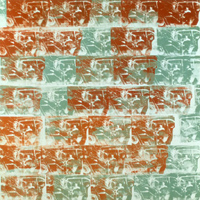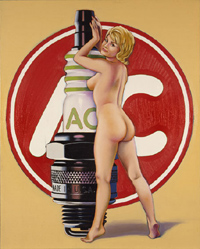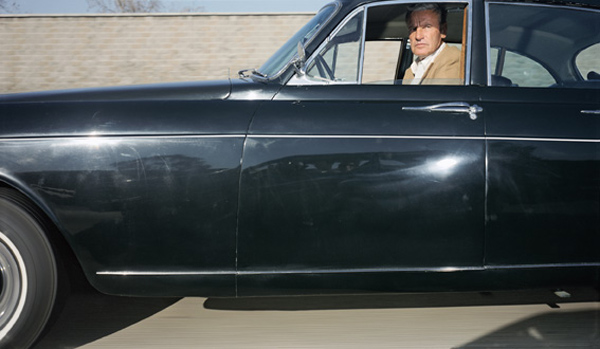The automobile is the foremost cultural touchstone of the 20th century, reflecting the social and cultural development of the western world and beyond. Automobility, or “self-propulsion” was a power the messengers to the gods already had at their disposal but it really bacame effective in 1886 when Carl Benz designed the famous Benz patented motorcar, the world’s first automobile. The exhibition demonstrates the wide range of art influenced by the automobile featuring more than 80 artists, from Giacomo Balla and Jean Tinguely to Andy Warhol and Richard Prince.
 Andy Warhol, Optical Car Crash, 1962 Kunstmuseum Basel, Ankauf 1970 © 2011 Pro Litteris, Zürich The Andy Warhol Foundation for the Visual Arts Photo: Kunstmuseum Basel, Martin P. Bühler
The exhibition, which is conceived architecturally as a wheel with axis and radial segments, commences with the radical new concepts of art and society put forth by the Futurists, who linked human and machine symbiotically in a new aesthetic of constant acceleration. In the “Futurist Manifesto” of 1909, Filippo Tommaso Marinetti propagated automotive speed and the racecar as new ideal of beauty to replace the old model of the Nike of Samothrace. The Futurists worshipped the machine realm, dedicated poems to the racecar and struck up a “Hymn to Death.” In the visual arts Giacomo Balla and Luigi Russolo were the main figures to depict impressions of automotive movement as synaesthesia of light, sound and speed in the urban environment. These two artists form the historical prelude to the exhibition, with their own room in which visitors can experience the intoxication of the senses triggered by a panorama of works.
Pop Art and Nouveau Réalisme
Two larger galleries in the show are devoted to high points of the automotive worldview in the art of the 1960s and 70s. In many works of American Pop Art and its forerunners, the “American way of life,” genuinely bound up as it is with the car and the mobile lifestyle, along with its propagation in the mass media, is the chosen theme of artists such as Andy Warhol and his “Disaster Series” Ed Ruscha, Roy Lichtenstein and Don Eddy. In Europe on the other hand, it was the Nouveau Réalisme movement exemplified by the works of Arman, César, Mimmo Rotella that transformed the commodities of machine and automobile into art, whether by splashing them across posters or by layering, compressing or degenerating their material forms. Museum Tinguely has several works in its collection that were directly inspired by cars. Jean Tinguely for example warned of the transience of western consumer culture by means of a drivable sculpture crafted from a Renault Safari and arranged Eva Aeppli’s “Five Widows” with a Lotus racecar he had purchased (once driven by world champion Jim Clark). With Wolf Vostell and Allan Kaprow, two of the main figures in Happening and Performance Art, are also represented.
 Mel Ramos, Kar Kween, 1964 Hirshhorn Museum and Sculpture Garden, Smithsonian Institution, Washington, DC, Gift of Joseph H. Hirshhorn, 1966 © 2011 ProLitteris, Zürich. Photo: Lee Stalsworth
The stroll through the art history of automotive inspiration is accompanied by a second, theme-based, thread. The visitor can choose to approach the exhibition by way of art that fell under the sway of commodity fetishism (lacquer and chrome, the car acquisition as purchase of fictions and redirection activity, assembly line production and accumulation) with works from Arman to Peter Stämpfli; or religious fetishism (auto da fé, “Déesse,” nail fetish and car cemetery) with works from Kudjoe Affutu to Superflex; or sexual fetishism (phallic extension, motor potency, female curves, the car as bachelor machine) with works from Liz Cohen to Pipilotti Rist. Further apotheoses of the automotive state of mind can be found in rooms focusing on themes such as the accident (Brassaï, Robert Frank, etc.); on speed (Horst Baumann, Richard Prince, Man Ray, etc.); and on traffic (Andreas Feininger, Julian Opie, etc.) ; on retreat and Flight (Edward Kienholz, Betsabeé Romero, etc.). In the middle, set up as axis of the entire show, is Damián Ortega’s large-scale work "Cosmic Thing,” a VW Beetle exploded through the space.
PUBLICATION
The catalogue illuminates our complex relationship to the automobile in numerous essays from a broad range of cultural-historical, sociological and psychological
perspectives. One essay treats Jean Tinguely’s autophilia. 364 pages, edited by Kehrer, Heidelberg, published in German and English.
To see more illustrations, click on VERSION FRANCAISE at the top
of this page
|










